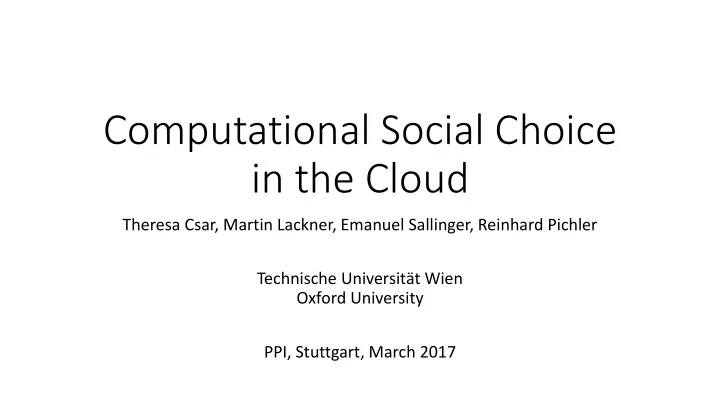

Computational Social Choice in the Cloud Theresa Csar, Martin Lackner, Emanuel Sallinger, Reinhard Pichler Technische Universität Wien Oxford University PPI, Stuttgart, March 2017
By Sam Johnston [CC BY-SA 3.0 (http://creativecommons.org/licenses/by-sa/3.0)], via Wikimedia Commons
Cloud Computing Technologies Pregel MapReduce GraphX Giraph Spark Hadoop
MapReduce Map Phase The input data is mapped to (key,value)-pairs Shuffle Phase The (key,value)-pairs are assigned to the reduce tasks Reduce Phase Each reduce task performs a simple calculation on all its values
What‘s an election? Given as lists of preferences with n votes and m candidates. We are interested in finding the best candidate, or the set of best candidates.
MapReduce and Elections by Example Given a set of m = 3 candidates a,b,c and n voters. Each voter provides a ranking of candidates, e.g.: a > b > c Borda Scoring Rule: The candidate ranked first receives m−1 points, the second m−2 points, etc.
MapReduce and Elections by Example – Borda Scoring Rule
Performance Analysis of a Mapreduce Computation • data replication rate (rr) • number of MapReduce rounds • number of keys / reduce tasks • wall clock time (wct): the maximum time consumed by a single computation path in the parallel execution of the algorithm • total communication cost (tcc): number of values transferred during the computation.
Performance – Borda Scoring Rule The scores of all candidates given a scoring rule can be computed using MapReduce with the following characteristics: rr = 1, # rounds= 1, # keys = m, wct ≤ n, and tcc ≤ mn.
Winner Determination in Elections • Scoring Rules: Borda Scoring Rule, … • Copeland Set: The Copeland set is based on Copeland scores. The Copeland score of candidate a is defined as |{b ∈ C : a > b}|−|{b ∈ C : b < a}|. The Copeland set is the set of candidates that have the maximum Copeland score. • The Smith set is the (unique) smallest set of candidates that dominate all outside candidates. • The Schwartz set is the union of minimal sets that are not dominated by outside candidates.
Winner Determination in Elections Input Data Preference-Lists (Scoring Rules) • Number of Lists / Number of Votes • Length of Votes / Number of Candidates Dominance Graph (Smith Set, Copeland Set, Schwartz Set) • Number of Candidates
Smith Set Definition Candidate a is in the Smith set if and only if for every candidate b there is a path from a to b in the weak dominance graph. Brandt,Fischer and Harrenstein (2009) show that in the weak dominance graph a vertex t is not reachable from a vertex s if and only if there exists a vertex v such that D2(v) = D3(v), s ∈ D2(v), and t / ∈ D2(v). In other words: We only need paths of length 3 to find the Smith Set.
Smith Set Algorithm-sketch • Preprocessing step (create needed datastructure) • 2 MR-Rounds: to find paths of length 2 und 3 (or 4) • Postprocessing: find vertices contained in the Smith set
Smith Set – Vertex Datastructure „Think like a vertex “ Each vertex saves three sets storing information on incoming and outgoing edges for a vertex a as follows: • the set old stores all vertices that have been found previously to be reachable from a; • the set new stores all vertices that have been found in the last map- reduce round to be reachable from a; • the set reachedBy stores all vertices known to reach a;
Vertex Data Structure – in action
Experimental Design • Mapreduce Java Implementation github.com/theresacsar/bigvoting • Amazon Web Services (AWS) – Elastic Compute Cloud • Synthetic Datasets • with varying number of candidates and edges in the dominance graph (m=7000 candidates and m2/10 edges) • up to 128 EC2 instances
Future Work – Exploring other Technologies • Pregel (Giraph, GraphX ) „Think like a vertex “ • Pregel-like systems are better suited for iterative Graph computations • Spark • Interactivity • Data is loaded in memory
Future Work • Other Technologies • Using real word data • Results from search engines • Other Rules for Winner Determination
Thank you for listening! ask questions now or send me an email csar@dbai.tuwien.ac.at ☺
Recommend
More recommend